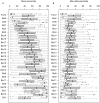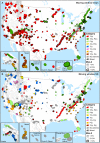Climate exposure of US national parks in a new era of change
- PMID: 24988483
- PMCID: PMC4079655
- DOI: 10.1371/journal.pone.0101302
Climate exposure of US national parks in a new era of change
Abstract
US national parks are challenged by climate and other forms of broad-scale environmental change that operate beyond administrative boundaries and in some instances are occurring at especially rapid rates. Here, we evaluate the climate change exposure of 289 natural resource parks administered by the US National Park Service (NPS), and ask which are presently (past 10 to 30 years) experiencing extreme (<5th percentile or >95th percentile) climates relative to their 1901-2012 historical range of variability (HRV). We consider parks in a landscape context (including surrounding 30 km) and evaluate both mean and inter-annual variation in 25 biologically relevant climate variables related to temperature, precipitation, frost and wet day frequencies, vapor pressure, cloud cover, and seasonality. We also consider sensitivity of findings to the moving time window of analysis (10, 20, and 30 year windows). Results show that parks are overwhelmingly at the extreme warm end of historical temperature distributions and this is true for several variables (e.g., annual mean temperature, minimum temperature of the coldest month, mean temperature of the warmest quarter). Precipitation and other moisture patterns are geographically more heterogeneous across parks and show greater variation among variables. Across climate variables, recent inter-annual variation is generally well within the range of variability observed since 1901. Moving window size has a measureable effect on these estimates, but parks with extreme climates also tend to exhibit low sensitivity to the time window of analysis. We highlight particular parks that illustrate different extremes and may facilitate understanding responses of park resources to ongoing climate change. We conclude with discussion of how results relate to anticipated future changes in climate, as well as how they can inform NPS and neighboring land management and planning in a new era of change.
Conflict of interest statement
Figures





References
-
- National Parks Second Century Commission (2009) Advancing the National Park Idea: Science and Natural Resource Committee Report. National Parks Conservation Association. Available: http://www.npca.org/assets/pdf/Committee_Science.PDF. Accessed 2014 May.
-
- National Academy of Public Administration (2010) Strengthening America’s Best Idea: An Independent Review of the National Park Service’s Natural Resource Stewardship and Science Directorate. Washington DC: National Academy of Public Administration. Available: http://www.napawash.org/wp-content/uploads/2010/08/09-05.pdf. Accessed 2014 May.
-
- National Park System Advisory Board (2012) Revisiting Leopold: Resource Stewardship in the National Parks. Washington DC: National Park System Advisory Board. Available: http://www.nps.gov/calltoaction/PDF/LeopoldReport_2012.pdf. Accessed 2014 May.
-
- Cole DN, Landers PB (1996) Threats to wilderness ecosystems: Impacts and research needs. Ecol Appl 6: 168–184.
-
- Heller NE, Zavaleta ES (2009) Biodiversity management in the face of climate change: A review of 22 years of recommendations. Biol Conserv 142: 14–32.
Publication types
MeSH terms
LinkOut - more resources
Full Text Sources
Other Literature Sources
Medical
Miscellaneous

